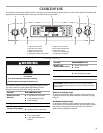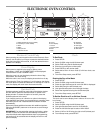
12
OVEN USE
Odors and smoke are normal when the oven is used the first few
times, or when it is heavily soiled.
During oven use, the heating elements will not remain on, but will
cycle on and off throughout oven operation.
IMPORTANT: The health of some birds is extremely sensitive to
the fumes given off. Exposure to the fumes may result in death to
certain birds. Always move birds to another closed and well-
ventilated room.
Aluminum Foil
IMPORTANT: To avoid permanent damage to the oven bottom
finish, do not line the oven bottom with any type of foil or liner.
■ For best cooking results, do not cover entire rack with foil
because air must be able to move freely.
■ To catch spills, place foil on rack below dish. Make sure foil is
at least ½" (1.3 cm) larger than the dish and that it is turned
up at the edges.
Bakeware
The bakeware material affects cooking results. Follow
manufacturer’s recommendations and use the bakeware size
recommended in the recipe. Use the following chart as a guide.
Meat Thermometer
On models without a temperature probe, use a meat
thermometer to determine whether meat, poultry and fish, are
cooked to the desired degree of doneness. The internal
temperature, not appearance, should be used to determine
doneness. A meat thermometer is not supplied with this
appliance. Follow manufacturer's directions for using a meat
thermometer.
Oven Vent
The oven vent releases hot air and moisture from the oven, and
should not be blocked or covered. Blocking or covering the vent
will cause poor air circulation, affecting cooking and cleaning
results. Do not set plastics, paper or other items that could melt
or burn near the oven vent.
Positioning Racks and Bakeware
IMPORTANT: To avoid permanent damage to the porcelain
finish, do not place food or bakeware directly on the oven door or
bottom.
RACKS
■ Position racks before turning on the oven.
■ Do not move racks with bakeware on them.
■ Make sure racks are level.
To move a rack, pull it out to the stop position, raise the front
edge, then lift out. Use the following illustration and chart as a
guide.
BAKEWARE/
RESULTS
RECOMMENDATIONS
Light colored
aluminum
■ Light golden crusts
■ Even browning
■ Use temperature and time
recommended in recipe.
Dark aluminum and
other bakeware with
dark, dull and/or
nonstick finish
■ Brown, crisp
crusts
■ May need to reduce baking
temperatures slightly.
■ Use suggested baking time.
■ For pies, breads and casseroles,
use temperature recommended in
recipe.
■ Place rack in center of oven.
Insulated cookie
sheets or baking
pans
■ Little or no bottom
browning
■ Place in the bottom third of oven.
■ May need to increase baking time.
Stainless steel
■ Light, golden
crusts
■ Uneven browning
■ May need to increase baking time.
Stoneware/Baking
stone
■ Crisp crusts
■ Follow manufacturer’s instructions.
Ovenproof
glassware, ceramic
glass or ceramic
■ Brown, crisp
crusts
■ May need to reduce baking
temperatures slightly.
A.Oven vent
FOOD RACK
POSITION(S)
Toasting bread or broiling thin, non-fatty foods. 7
Most broiling and multiple rack baking. 6
Multiple rack baking. 5
Most baked goods on cookie sheet or jelly roll
pan, fruit pies, or frozen convenience foods.
Also broiling chicken pieces or multiple rack
baking.
4
A
7
6
5
4
3
2
1


















